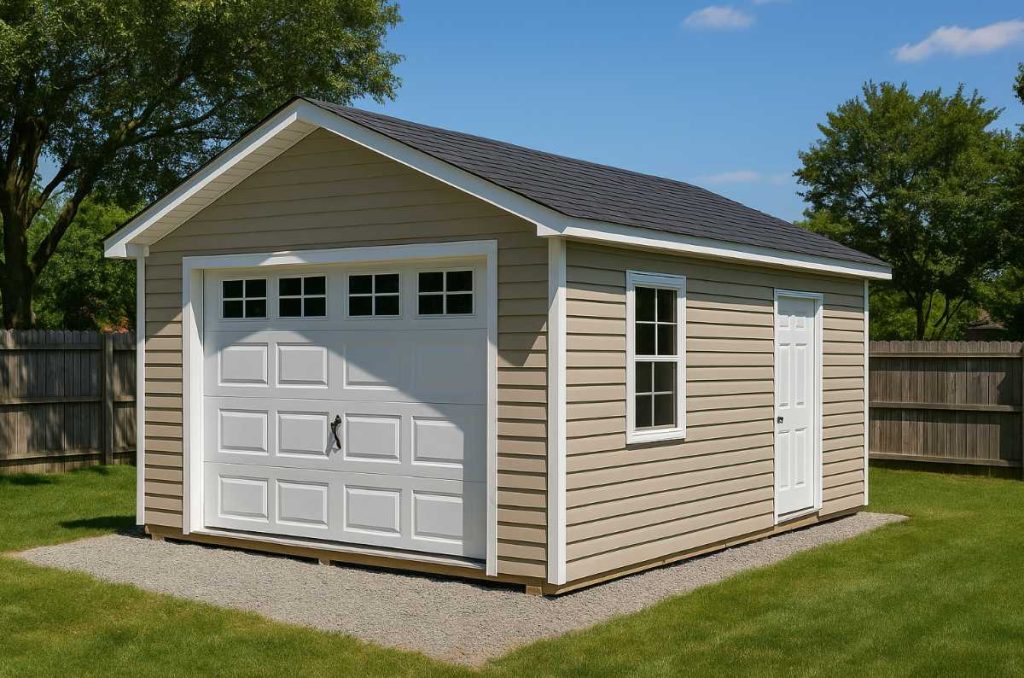Look, I get it. You’re standing in your driveway, watching the rain pelt down on your car for the third time this week, and thinking there’s got to be a better way.
Maybe you’ve been tossing up between building a proper garage from scratch or going with something pre-made. Here’s the thing – most people assume traditional construction is the only legitimate option, like it’s somehow more “real” than a prefab. But that thinking is pretty outdated.
The garage game has changed massively over the past decade. What used to be a choice between expensive custom builds and flimsy tin sheds has evolved into something far more interesting. Today’s prefab structures aren’t what your uncle bought back in the 90s.
We’re talking about quality builds that can rival anything constructed on-site, but without the headaches that come with traditional construction projects.
Let’s be honest about what most traditional builds actually involve. You’re looking at months of coordination between architects, builders, and council approval processes.
Then there’s the constant stream of tradies turning up at different times, the neighborhood complaints about noise, and the inevitable cost blowouts when someone discovers the soil isn’t quite right or materials get delayed. Meanwhile, your car is still sitting outside getting hammered by the elements.
A prefab one car garage sidesteps most of these problems entirely. But before we dive into why, let’s clear up what we’re actually talking about here. These aren’t those cheap kit garages that look like they’d blow over in a decent storm.
Modern prefab garages are built by skilled craftspeople in controlled workshop environments, then delivered to your property ready for installation. Think of it like buying a quality piece of furniture – it’s made properly, just not on your property.
The cost conversation nobody wants to have
Right, let’s talk money because that’s usually where these discussions end up anyway. Traditional garage construction in the U.S. can easily set you back anywhere from $35,000 to $50,000 for a single-car space. That’s not a small chunk of change for most families.
The costs add up quickly when you factor in everything: site preparation, foundation work, framing, roofing, electrical work, and all the finishing touches.
Prefab options typically run you about 25 to 40 percent less than traditional builds. Why the massive difference? Well, when builders construct garages in a workshop setting, they’re not dealing with weather delays, they’ve got all their tools and materials right there, and they’re working on multiple projects simultaneously. That efficiency translates directly into savings for you.
But here’s where it gets interesting. The savings don’t just come from the build itself. Traditional construction requires expensive concrete foundations, extensive site preparation, and usually some landscaping repair afterward because the construction process tears up your yard.
Prefab garages can often sit on much simpler foundations – sometimes just compacted gravel or concrete piers. That alone can save you several thousand dollars.
Then there’s the hidden costs that nobody warns you about with traditional builds. The endless cups of tea for tradespeople, the time off work to meet with various contractors, the stress of managing a construction project when you’ve got no experience doing it. These things might not show up on an invoice, but they cost you plenty.
Time is actually money in this equation

Here’s a question: how long are you willing to wait for a garage? Because with traditional construction, you’re typically looking at anywhere from three to six months from the moment you sign the contract to when you can actually park your car inside. That’s assuming everything goes smoothly, which it rarely does.
Prefab garages can be up and functional in a matter of weeks. The actual installation often happens in a single day. Seriously. The company shows up with the structure, a crane in some cases, and by the end of the day, you’ve got a garage. Sure, there might be some finishing touches over the next few days, but we’re talking weeks, not months.
This speed matters for more than just convenience. Every month your car sits outside is another month of sun damage to the paint, potential hail damage, and wear on the interior. If you’re in Miami or Phoenix, that harsh sun can do real damage over a few months. In Chicago, it’s more about the snow and those surprise hailstorms that seem to pop up when you least expect them.
And let’s not forget about the disruption factor. Traditional garage construction means your property becomes a building site for months. There’s noise, dust, trucks coming and going, and your normal routine goes out the window. With prefab installation, the disruption is measured in days, not months. Your neighbors will actually still be talking to you when it’s all done.
Quality control that actually means something
One of the biggest misconceptions about prefab garages is that they’re somehow lower quality than site-built options. That’s backwards thinking. When a garage is built in a controlled workshop environment, every joint is checked, every measurement is precise, and the whole structure is assembled in conditions where quality control is actually possible.
Think about it. Traditional construction happens outside, in whatever weather shows up that day. Rain can affect timber quality, wind can blow dust into fresh paint, and temperature swings can affect how materials set. Workshop construction eliminates all these variables.
Companies like storageshedsandgarages.com that specialize in these builds have the process down to a science, particularly when they’re built by Amish craftspeople who bring generations of building expertise to every project.
The Amish building tradition is pretty remarkable when you think about it. These folks have been constructing durable structures for centuries without cutting corners. When that level of craftsmanship meets modern prefab efficiency, you get garages that are built to last. We’re talking structures that’ll still be standing strong in 30 years, not falling apart after the first decent storm.
Customization isn’t just for fancy builds
Here’s another myth worth busting: prefab doesn’t mean one-size-fits-all. Modern prefab garage companies offer extensive customization options. Want a specific roof style to match your house? Done. Need extra height for a lifted truck? No problem. Want windows on the side, or a specific door configuration? All available.
The customization process is actually often simpler with prefab builders. You work through a clear list of options, make your selections, and that’s what gets built. With traditional construction, every custom feature needs to be discussed, quoted, and potentially negotiated with your builder. Changes mid-project can blow out costs dramatically.
You can choose from various styles, colors, and finishes. Whether you’re after something that matches your home’s weatherboard aesthetic or you want a more modern look, the options are there. Many prefab companies now offer 3D visualization tools so you can see exactly what your garage will look like before it’s built.
The beauty of working with experienced prefab builders is they’ve seen it all before. They know what works and what doesn’t. They can tell you if that design idea you found on Pinterest is actually practical or if there’s a better solution that’ll serve you better in the long run.
The permit and planning headache reducer
Let’s be real about permits and council approvals – they’re nobody’s favorite part of any building project. But here’s something that might surprise you: prefab garages often have a much smoother approval process than traditional builds.
Many prefab garage providers handle the permit side of things as part of their service. They know exactly what documentation councils need because they’ve done it hundreds of times before. They understand the local regulations, they’ve got the engineering certificates ready to go, and they can walk you through the whole process without you needing to become an expert in building codes.
Traditional builds often require you to coordinate between your builder, an engineer, possibly an architect, and the council. Each party has different requirements and timelines, and you’re stuck in the middle trying to make it all work. Prefab companies streamline this because they’re handling the entire process.
Some councils have specific exemptions or simplified processes for prefab structures under certain sizes. A good prefab garage company will know all these loopholes and can help you take advantage of them. That could mean the difference between a simple approval process and months of back-and-forth with council planners.
Flexibility you didn’t know you needed
Here’s something that doesn’t get talked about enough: prefab garages can move with you. Not that you’d necessarily want to dismantle and relocate your garage every time you move house, but it’s an option. Try doing that with a traditional build attached to a concrete slab.
This flexibility extends beyond just physical relocation. Say you put in a single-car garage, use it for a few years, then decide you need more space. Many prefab systems can be expanded or modified much more easily than traditional structures. You’re not locked into your initial decision forever.
The modular nature of prefab construction also means repairs and modifications are more straightforward. If a panel gets damaged, it can often be replaced without tearing apart the entire structure. Try patching up damage to a traditionally built garage and you’ll quickly appreciate the modular approach.
Environmental considerations that actually matter
If you care about your environmental impact, prefab construction has some genuine advantages. Workshop-based building produces significantly less waste than on-site construction. When builders are working in one location with proper systems in place, materials get used more efficiently. Offcuts can be used for other projects, and waste gets sorted and recycled properly.
Traditional construction sites, on the other hand, are notorious for waste. Partially used material packages, damaged goods, and general construction debris often end up in landfill. There’s also the environmental cost of multiple trucks making trips to your property over months of construction, compared to the single delivery of a prefab structure.
Many prefab manufacturers are also investing in sustainable materials and energy-efficient construction methods because it makes business sense. When you’re building the same type of structure repeatedly, improving efficiency and sustainability has a direct impact on the bottom line.
The workshop advantage nobody talks about
Beyond just vehicle storage, a well-built garage becomes valuable space for hobbies, projects, or a home business. The thing about prefab garages is they’re often better suited to these alternate uses than traditional builds.
Because prefab structures are designed to be weatherproof from day one, you can start using the space immediately. There’s no waiting for paint to cure or dealing with off-gassing from various construction materials. The space is ready to go.
Many people discover that their prefab garage actually becomes their favorite space on the property. It’s got that proper finished feel without the stuffiness of being attached to the house. Perfect for that home gym setup, the workshop you’ve been planning, or just somewhere to escape and tinker with projects.
Insurance and property value angles
When you add any structure to your property, insurance and property value become considerations. Prefab garages, when properly installed and maintained, add value to your property just like traditional builds. The key is choosing a quality structure and having it professionally installed on proper foundations.
Insurance companies treat properly built prefab garages similarly to traditional structures. You’ll need to update your home insurance to cover the new garage, but there shouldn’t be any premium issues assuming you’ve gone with a reputable builder and followed proper installation procedures.
From a property value perspective, any garage adds appeal to a home. Buyers love off-street parking and storage space. Whether that garage was built on-site or arrived prefabricated becomes largely irrelevant once it’s been there for a while and proven its durability.
Making the decision that works for you
Look, prefab garages aren’t perfect for every situation. If you’re building a massive four-car garage with living space above and you want it integrated into your home’s architecture, then traditional construction might be your better bet. But for most people wanting to add a single-car garage to their property, prefab options deliver better value, faster results, and less stress.
The key is choosing a reputable builder who stands behind their work. Ask about warranties, look at examples of their completed projects, and don’t be shy about asking for customer references. A good prefab garage company will be happy to provide all this information.
Think about what matters most to you. Is it getting the job done quickly? Saving money? Minimizing disruption to your daily life? Knowing exactly what the final cost will be before work starts? Prefab options score well on all these factors.
At the end of the day, you want a garage that protects your vehicle, provides useful storage space, and doesn’t cause you grief during the installation process. Modern prefab options tick all these boxes while offering real advantages over traditional construction. The technology and craftsmanship behind today’s prefab garages have come so far that the old stigma around “kit garages” is completely outdated.
Your car deserves better than sitting out in the weather, and you deserve better than spending six months and fifty grand getting a simple garage built. Sometimes the smarter choice is the one that gets you the result you need without all the drama. That’s what prefab garages offer: a straightforward solution to a common problem, built properly by people who know what they’re doing, delivered when they say they will, and at a price that makes sense.
The question isn’t really whether prefab garages are “good enough” compared to traditional builds anymore. For most applications, they’re actually the better choice. The question is just finding the right one for your needs and getting on with enjoying the benefits of having proper vehicle storage and workshop space on your property.





